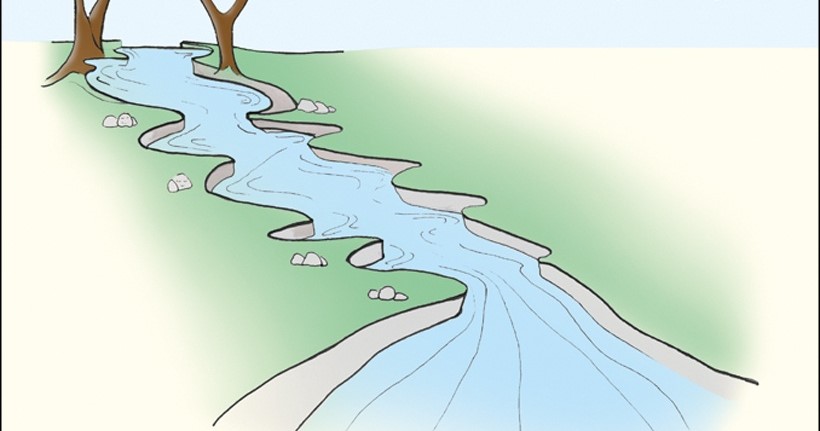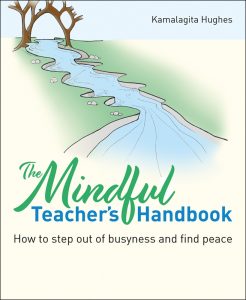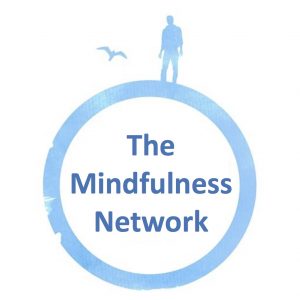
~ written by Kamalagita Hughes who completed the Teacher Training Pathway at Bangor University in 2018. Kamalagita is the Education Lead for Mindfulness in Action and a Lead Trainer for the Mindfulness in Schools Project (MiSP). Kamalagita’s book, The Mindful Teacher’s Handbook was published in August 2022 – a practical and engaging resource to help everyone in schools bring mindfulness into their lives in a meaningful way ~
One evening, whilst teaching a Mindfulness course to teachers, I decided to mix things up. Instead of introducing the ‘hot cross bun’ model via the ‘walking down the street’ scenario, I chose to use a school observation as the context. Little did I know that one of the participants had just come from exactly that situation. She said, ‘When you were describing the hot cross bun on the board, I felt like I was seeing my own mind.’ That’s when the idea for ‘The Mindful Teacher’s Handbook’ was seeded.
In 2017, Rebecca Crane and others authored a paper on what makes a Mindfulness-based Programme.[1] In that paper they discussed Mindfulness-based programmes in terms of the ‘Warp and the Weft.’ Sewists among you will know that the Warp are the threads that run vertically through a garment, keeping the material together. The Weft threads are woven horizontally through the Warp threads adding uniqueness and stability. A garment needs both. As Mindfulness continues to weave itself into society, it’s essential to know which are the warp threads that will give coherence to a mindfulness programme with the research and teaching, and how to spin weft threads that can be woven through a programme so that it’s more relevant and tailored to its audience.
This was never more true when it comes to teachers and school staff who, post-pandemic, are facing unprecedented levels of stress. Staff shortages, higher than ever pupil absenteeism and in some schools, a doubling of the number of child protection cases, are just some of the crises facing school staff on a daily basis. Mindfulness – the ability to find calm in the moment and step back and find perspective, has never been more needed. Research shows how teachers ‘create the weather in the classroom’ and have a huge influence on the well-being of pupils.[2] But how can you ask a teacher to do a daily 40 minute body scan when it’s a challenge for them to get to the loo for several hours in the working day?
I come from a long line of teachers and although I resisted it for a long time, ended up in the classroom because I love seeing people learn and am fascinated by the process. I understood the pressures of the classroom and I had taught a number of mindfulness courses to school staff. Although highly appreciative of it at the time, many found it difficult to maintain a mindfulness practice outside the structure of the course (which goes across the board for mindfulness-based programmes). Added to this, although there was interest, many school staff could not find the time to commit to a mindfulness course on top of a long working day. I wanted to create a resource to help school staff both develop and maintain practice, but I knew some new weft threads were needed.
I was aware of several teachers/school staff who had completed a mindfulness course and maintained a practice and so decided to talk to them. They were aware of the warp threads – what mindfulness is and isn’t. But they had made the practice their own and wove it through their school day. As in the fairy tales, could they be the ones spinning gold? I decided to find out.
Many years ago, I trained as a documentary film-maker and so employed the same methods – interviewing staff, transcribing the interviews and seeing which threads stood out as common themes. Unsurprisingly the stress of inspections or observations were visible, or managing difficult behaviour or finding time for yourself. But also threads of creativity emerged and the overwhelming sense of care that school staff have for their pupils and desire to champion them. Out of these threads emerged ‘The Mindful Teacher’s Handbook.’

I’ve aimed to make it a lively and engaging blend of top tips, research evidence, case studies, guided meditations and suggested exercises for all – both for those new to mindfulness and for those who want to refresh their practice. Interestingly enough, the recent, large scale, MYRIAD study found that “Schoolteachers can benefit from mindfulness training and this can potentially benefit students through improved teacher-wellbeing, class room instruction and school climate.”[3]
Going back to the ‘Warp’ and the ‘Weft,’ it was lovely to receive this review from Rebecca Crane:
“It offers rich resources supporting you to keep your mindfulness practice going, and to creatively adapt it to you and your life. It also gives you very practical ideas, tailored to the school teaching context, on how to realise the fruits of your mindfulness practice in everyday life – both during routine and high stress times. If you are a school teacher this book has your back.”
– Prof Rebecca Crane, PhD, Director, Centre for Mindfulness Research and Practice, Bangor University, UK
The Mindful Teachers Handbook is available from Crownhouse Publications: https://www.crownhouse.co.uk/the-mindful-teachers-handbook

I’ve been practicing mindfulness for 25 years and teaching it for 15. I’m a qualified teacher and lecturer with substantial experience in the classroom and in teacher training, further education and higher education. I’m also the education lead for Mindfulness in Action and a lead trainer for the Mindfulness in Schools Project (MiSP)
[1] Crane, R., Brewer, J., Feldman, C., Kabat-Zinn, J., Santorelli, S., Williams, J., & Kuyken, W. (2017) What defines mindfulness-based programs? The warp and the weft. Psychological Medicine, 47(6), 990-999.
[2] Weare, K., and Bethune, A. (2021). Implementing Mindfulness in Schools: An Evidence-Based Guide
[3] Montero-Marin J, Allwood M, Ball S, et al. Evid Based Ment Health Epub ahead of print: 16/05/22 doi:10.1136/ ebmental-2022-300439




